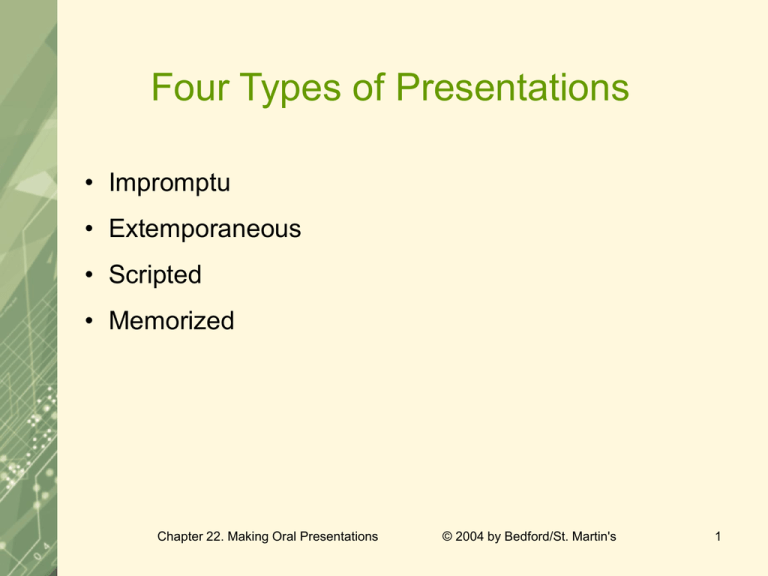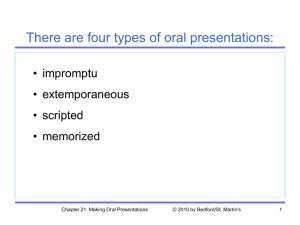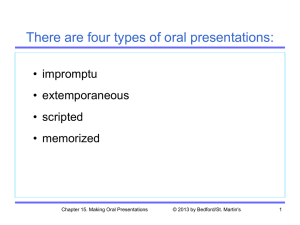Chapter 22
advertisement

Four Types of Presentations • Impromptu • Extemporaneous • Scripted • Memorized Chapter 22. Making Oral Presentations © 2004 by Bedford/St. Martin's 1 Four Audiences for Oral Presentations • Colleagues in your organization • Clients and customers • Fellow professionals at technical conferences • The public Chapter 22. Making Oral Presentations © 2004 by Bedford/St. Martin's 2 Steps in Preparing an Oral Presentation • Assess the speaking situation. • How much does the audience know? • Are you attempting to inform or inform and persuade? • What are their attitudes towards your topic? • How much time do you have? • Prepare an outline or note cards. • Prepare presentation graphics. • Rehearse the presentation. Chapter 22. Making Oral Presentations © 2004 by Bedford/St. Martin's 3 Five Characteristics of Effective Graphics • Visibility • Legibility • 18-point font • 20-point font • 24-point font • Stick with sans-serif fonts • Simplicity • Clarity • Correctness Chapter 22. Making Oral Presentations © 2004 by Bedford/St. Martin's 4 Four Aspects to Consider in Planning Your Graphics • Length of the presentation • Audience aptitude and experience • Size and layout of the room • Equipment Chapter 22. Making Oral Presentations © 2004 by Bedford/St. Martin's 5 Basic Media for Oral Presentations • Computer presentations • Slide projector • Overhead projector • Chalkboard or other hard writing surface • Objects • Handouts • For details see table in text p.579-580 Chapter 22. Making Oral Presentations © 2004 by Bedford/St. Martin's 6 Delivering an Oral Presentation is More Challenging than Writing a Document for Two Reasons: • Listeners can't go back to listen again to something they didn't understand. • Because you are speaking live, you must maintain your listeners' attention, even if they are hungry or tired or the room is too hot. Chapter 22. Making Oral Presentations © 2004 by Bedford/St. Martin's 7 Use Language to Alert Your Listeners to: • Advance organizers • Summaries • Transitions Chapter 22. Making Oral Presentations © 2004 by Bedford/St. Martin's 8 Three Techniques to Help Make a Lasting Impression on Your Audience • Involve the audience. • Refer to people, not to abstractions. • Use interesting facts, figures, and quotations. Chapter 22. Making Oral Presentations © 2004 by Bedford/St. Martin's 9 Rehearsing an Extemporaneous Presentation • First stage – concentrate on content • Second stage – concentrate on flow and timing • Third stage – concentrate on style Chapter 22. Making Oral Presentations © 2004 by Bedford/St. Martin's 10 In Giving the Oral Presentation: • Calm your nerves. • Use your voice effectively. • Use your body effectively. Chapter 22. Making Oral Presentations © 2004 by Bedford/St. Martin's 11 Three Facts about Nervousness • You are much more aware of your nervousness than the audience is. • Nervousness gives you energy and enthusiasm. • After a few minutes, your nervousness will pass. Chapter 22. Making Oral Presentations © 2004 by Bedford/St. Martin's 12 Points to Consider When You Get Nervous before a Presentation • Realize that you are prepared. • Realize that the audience is there to hear you, not to judge you. • Realize that your audience is made up of individual people who happen to be sitting in the same room. Chapter 22. Making Oral Presentations © 2004 by Bedford/St. Martin's 13 Strategies for Dealing with Nervousness before a Presentation • Walk around. • Go off by yourself for a few minutes. • Talk with someone for a few minutes. • Take several deep breaths, exhaling slowly. Chapter 22. Making Oral Presentations © 2004 by Bedford/St. Martin's 14 Inexperienced Speakers Often Have Problems with Five Aspects of Vocalizing: • Volume • Speed • Pitch • Articulation • Nonfluencies Chapter 22. Making Oral Presentations © 2004 by Bedford/St. Martin's 15 Four Guidelines about Physical Movement • Maintain eye contact. • Use natural gestures. • Don't block the audience's view of the screen. • Control the audience's attention. Chapter 22. Making Oral Presentations © 2004 by Bedford/St. Martin's 16 Guidelines for Presenting to People from Different Cultures • Use graphics effectively to reinforce your points for nonnative speakers. • Be aware that gestures can have cultural meanings. Chapter 22. Making Oral Presentations © 2004 by Bedford/St. Martin's 17 Five Situations When You Respond to Questions • You're not sure everyone heard the question. • You don't understand the question. • You don't know the answer to the question. • You get a question that you have already answered in the presentation. • A belligerent member of the audience rejects your response and insists on restating his or her original point. Chapter 22. Making Oral Presentations © 2004 by Bedford/St. Martin's 18




